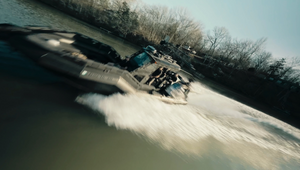
Getting That Impossible Shot on Land and Sea with Peyton Penuel

“You can be a fantastic operator with a jib at a festival swinging over a crowd, but doing it at 80 miles per hour, with another vehicle to factor in, is a whole new thing.”
Peyton Penuel is a gimbal and jib operator. In short, he makes cameras move, often at high velocity. Working with Nashville-based production solutions expert, Shift Dynamics – part of the Gear Seven family – this can take a lot of different forms.
Shift Dynamics has a wide array of sophisticated cinematic equipment, including a fleet of vehicles armed with tools to shoot productions of all sizes and styles on the move. An expert with the Motocrane Arm System deployed in car-to-car rigs, Peyton has recently been able to develop his skillset with the company’s latest addition: the Cinemarine Camera Boat – but more on that later.
It all started at high school, when a friend introduced Peyton to the world of video production. Soon, they enrolled in a class and created a commercial for the school, serving as inspiration for his future career after seeing it play before a film at their local cinema. “That is where I first got to see my work playing on a movie theatre screen,” he says. “Sitting in those seats at that moment, I was hooked.”
Further down the line, Peyton got his first outing with gimbal rigs while using glidecams to film weddings, eventually buying his own kit and pursuing gimbal operation and tech as a career path. “It’s something I never really knew was an option,” he says. “From there it was just natural to explore where I could place the gimbal, other than my own hands, and I got introduced to putting the gimbal on a jimmy jib.” That’s a lightweight camera crane, to you and me.
“From there, I began doing jib work in the live entertainment space, and still do that on occasion, but the team here at Shift noticed that I knew gimbals and cranes so they asked me to come alongside and eventually put me in the seat swinging the arm in the car.”
As exhilarating as it can be, when working as an arm car operator, Peyton says that safety is the biggest priority. “If you have a sick shot but almost took out a street light or a motorcycle rider, then it is not worth it.” Capturing these impressive visuals without endangering the crew or equipment is the result of many reps, developing the relationship between arm operator and driver until the communication is “unbreakable”, and Peyton can anticipate every move.
Equally important is his relationship with the cinematographer. “Simultaneously nailing where they want the arm, while maintaining where it needs to be in the space relative to the car and environment, is the biggest challenge,” he explains, “and one that does not really come right out the gate.”
Throughout his career as a camera operator, Peyton says not much has drastically changed in the way of technological evolutions – though the cranes themselves have become more accessible thanks to companies like Motocrane. “‘If it ain’t broke, don’t fix it’ kind of holds true to this subject, in my opinion,” he says, adding that most teams are using 10-year-old gimbals.
However, one impressive new development for Peyton’s own work has been the introduction of Shift Dynamics’ recently launched Cinemarine Camera Boat.
Made to be agile and weather various tough water conditions, the boat uses the same MotoCrane arm system Peyton has mastered with the car-to-car rigs, and he even had a hand in the design. “I built custom water-resistant cable connections for our monitors and power needs to be sure our gear all stays on and safe,” he says. “It has dedicated monitor stations for the DP and AC, while never worrying about suction cups or any soft mounting flopping around because it is rigid and purpose-built.
“We did a few rounds of testing to come up with a layout that worked well for all the operators needed, and to find the best placement for all devices – with safety always being at the front of our mind… We have been through various versions of mounting solutions for all the monitors, the crane itself, charging for batteries, and so on. There is nothing that we did not think through on this project.”
Describing his transfer of skills from car rig to boat rig, Peyton says that using the arm on the water is “both similar and different” to working on land.

“It is similar in the fact that you need to watch out for the tail hitting the roof of the boat in certain positions, and of course being careful not to go too low. But it’s different in the fact of adjusting for wind and vibrations.”
He explains, “The wind seems to behave completely differently out on the water, and you have to be able to counter the chop of the water that you don’t get on street applications. We have vehicles built for off-road use, and knowing how to counter that type of oscillation is beneficial but isn’t a one-to-one comparison at all. It is a form completely of its own, and I love that about it.”
The Shift Dynamics team has already used the Cinemarine Camera Boat for several undisclosed projects, allowing Peyton and the crew to capture shots that are “partially drone, partially technocrane, partially fixed mount”, all in one. “This makes us incredibly nimble for production and able to solve several problems all at once,” he adds.

“Cinemarine is a combination of everything we have all learned over the years. There is always a way to do a shot, but it is not often the right way. Sometimes you see people filming cars while hanging a gimbal out of the side of a minivan, and that is just not the way it needs to be done.
“Cinemarine was designed with that same mentality in mind. We have had situations in the past where a camera needed to be on the water, but a drone wasn’t the right tool, and building a jib on a pontoon just wasn’t it either. We now have that right tool: a safe, purpose-built system for getting that impossible shot.”















